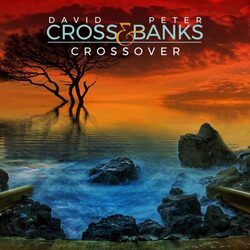
Let me come right out and say it: Peter Banks was my favorite of the Yes guitarists. He was there for the first two albums, only to be unceremoniously replaced with Steve Howe. In those two albums--Yes and Time and a Word—Peter was teamed with keyboardist Tony Kaye and drummer Bill Bruford, both Jazzers in their own ways. I had always wanted to see what Jazz expressions were to come from that incarnation of Yes. With Howe, the band took a more classical turn.
David Cross was who drew me to King Crimson in the first place. David was with that band from 1972-74, for me, the highwater mark of their phenomenal work. Larks’ Tongues in Aspic remains my favorite King Crimson album and David was a key part of that sound. That album also had drummer Bill Bruford, who had departed Yes and joined King Crimson.
Peter went on the form Flash and David to form the improvisational band Ascend. Their Jazz leanings kept their music on the borderlands between Prog and Jazz and their later bands respectively kept me interested and involved.
Now David has finished the project begun with Peter before the latter’s passing. Bringing along keyboardists Oliver Wakeman and Geoff Downes, bassist Billy Sherwood, Jeremy Stacey, Jay Schellen, and Pat Mastelotto on drums, David included Peter’s old bandmate Tony Kaye on Hammond Organ. It is a project whose times has truly come.
For a Jazz fan, all music can be interpreted as Jazz. This is certainly the case with Crossover.
The album opens with Rock to a Hard Place and features Geoff Downes on keyboards and Jeremy Stacey on drums. David’s violin introduces the melody and shows himself to be a masterful as he ever was. Peter’s guitar comes in with the crunchy stuff and they two of them trade off over the pulsing backbeat. If only these two had hooked up years ago.
They take an interlude excursion into more progressive sounds before returning to the opening movements and close out with the nod and a wink to their prog roots.
Upshift takes the duo into fascinating realms of rhythm and textures. Oliver Wakeman (Third person of the Wakeman Trinity) sits in on keyboards and Tony Kaye works his magic with the Hammond. Billy Sherwood (Yes’ successor to Chris Squire) joins on bass and Jay Schellen adds his drum work.
Sherwood and Wakeman know exactly how to be support David and Peter and the enhance what was already so well done. Tony Kaye’s Hammond work has always been legendary and his work here is both subtle and rich. Through it all, Peter and David retain the focus as should be. Upshift is an excellent piece and worthy of the artists and composers.
It has been said of Louis Armstrong that what he may have lost in technique, as he grew older, he more than made up with tonality. While David and Peter have lost nothing in technicality, their tonality has leapt so very far ahead of the “glory days.” As evidenced with David’s work with Stick Men on the Midori album (MoonJune 2015), David is better than ever.
The Smile Frequency with Oliver Wakeman on keys and Randy Raine-Reusch on World Instruments, is gorgeous and evocative. If smiles do indeed have a frequency, then the frequencies of this piece certainly made me smile.
The development of the song is multi-textual and polyrhythmic. Peter and David have drawn in so many varied elements and create a universal hymn of joy. The smile disappeared only when the song ended.
The Work Within features Andy Jackson’s sound effects of city life and the sounds of construction to open the song. David’s violin and Peter’s guitar crash like waves over and around the sound effects. Philosophically (or spiritually), the track sings of the ongoing edification of the soul and/or mind as beauty surrounds the process. The effected violin and guitar are colorful and so very enriching.
I love this song.
It is followed by Missing Time and is carried forth only by David and Peter. The reverbs and loops create layered expressions. The piece is ambient and meditative. The only thing missing is a discernible time signature. Go figure.
Plasma Drive sees the additional of King Crimson’s Pat Mastelotto on drums and drum synth with Wakeman and Sherwood. With David and Peter, this is a dream lineup. Plasma Drive has been called the fuel of the future, being able to overcome the inefficiencies of the internal combustion engine. David and Peter have captured that vision of the future and the supporting trio have expanded it. The song is futuristic without losing its foundation in the present.
Laughing Strange sees the return of Tony Kaye and Jeremy Stacey with Peter and David. David’s beautiful violin intonations are well-paired with Peter’s raw guitar. It is a yin and yang delivery of the message. Peter hands in some cold and choppy guitar phrases against David’s warm and lyrical violin. It is Peter’s most blistering guitar on the album and David’s most languid.
The album ends with the title track, Crossover. It is fitting that it is only the two of them—David and Peter—on this track. The two of them end the album as they began it, with the push-pull of their approaches and virtuosity. The piece is imaginative and fanciful.
It is impossible to avoid the wistfulness of what might have been with David Cross and Peter Banks, along with this lineup, back in the day. David’s violin brilliance and Peter’s guitar work is more beautiful than ever and the support of these astounding musicians with Peter and David make this album feel as monumental as the discovery of the Dead Sea Scrolls.
Bravo, David Cross, for finishing what you and Peter Banks started over seven years ago. It has truly been worth the wait.
~Travis Rogers, Jr. is The Jazz Owl
 RSS Feed
RSS Feed
